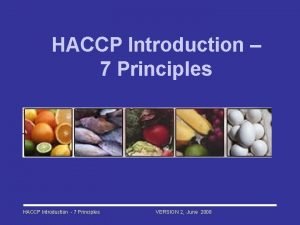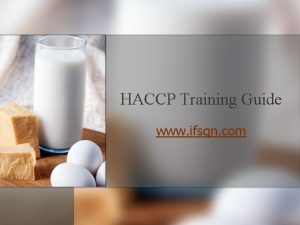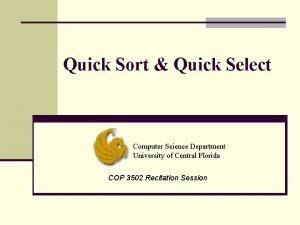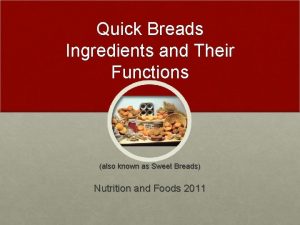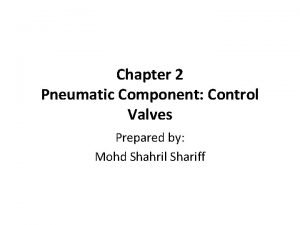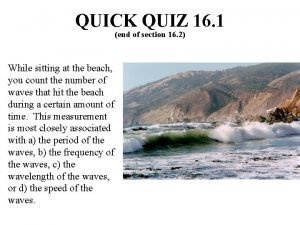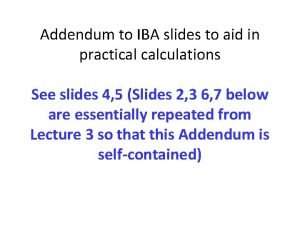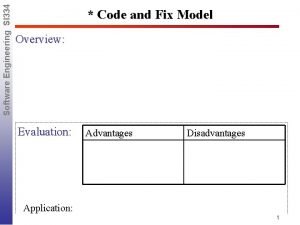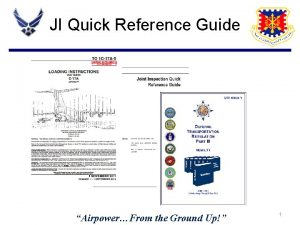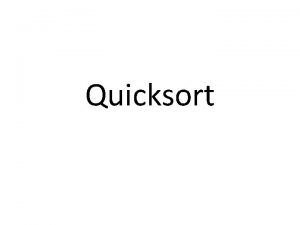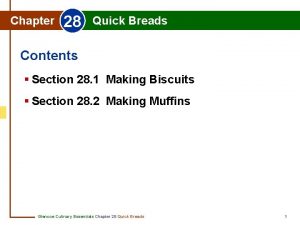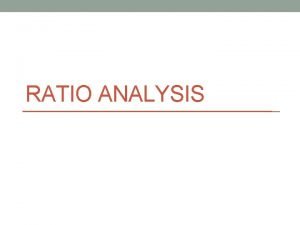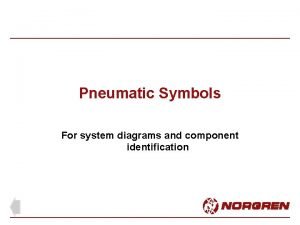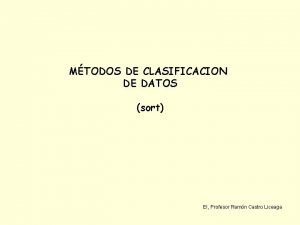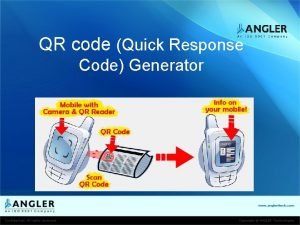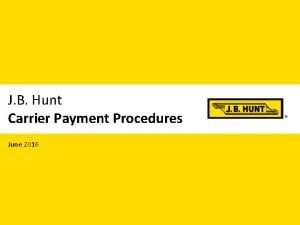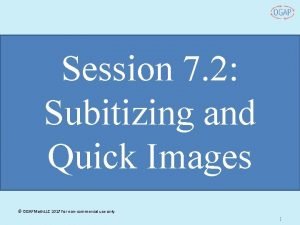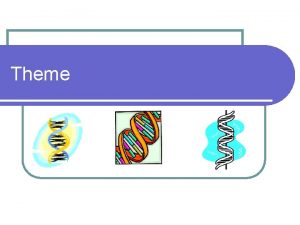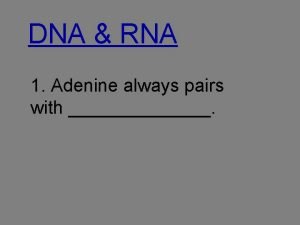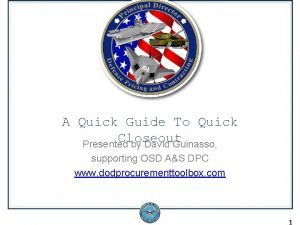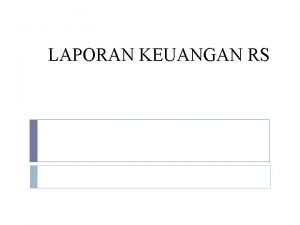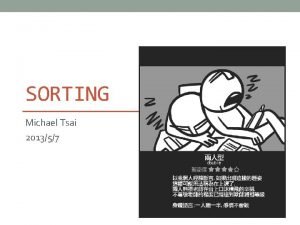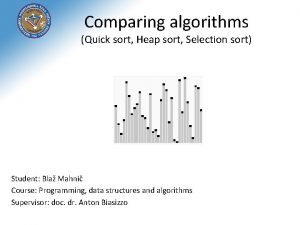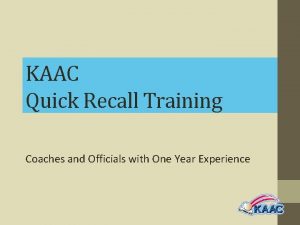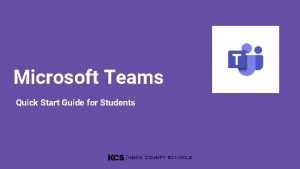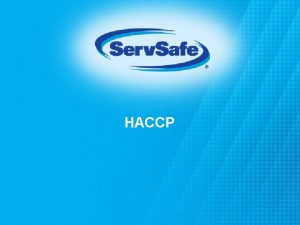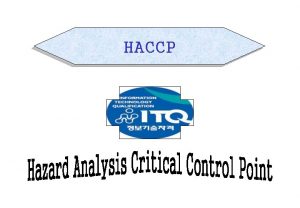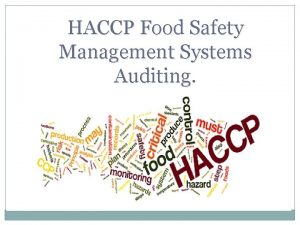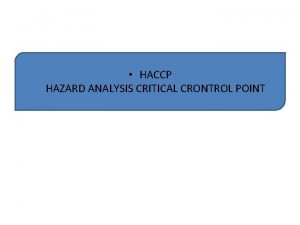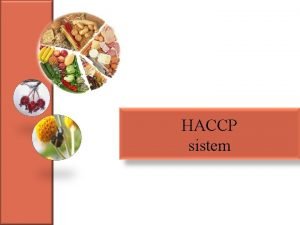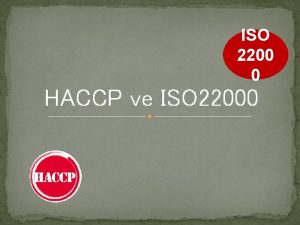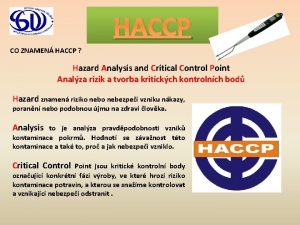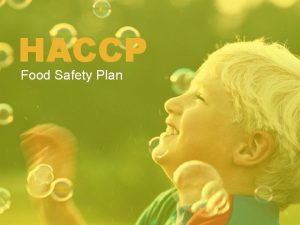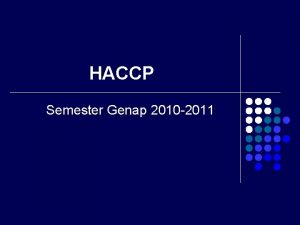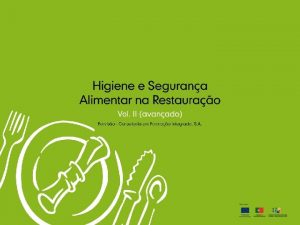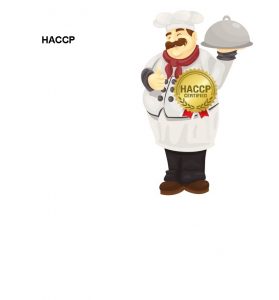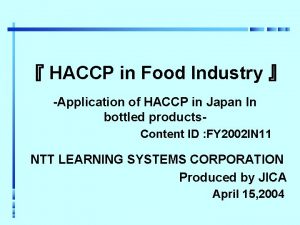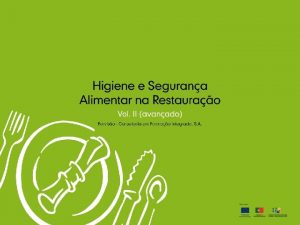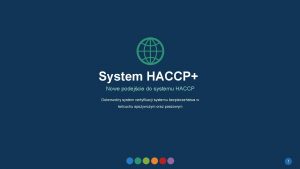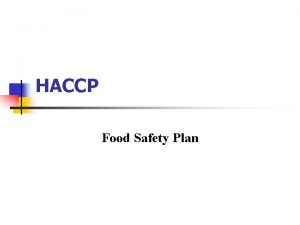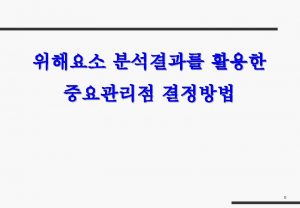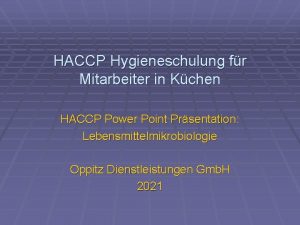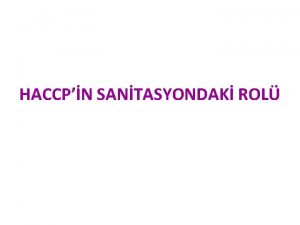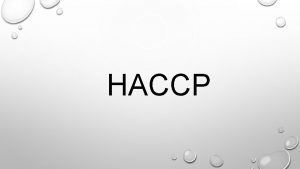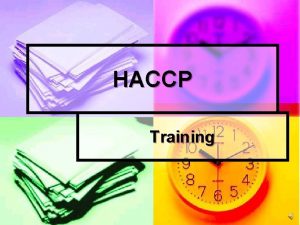Quick Steps to HACCP What is HACCP HACCP



































































- Slides: 67

Quick Steps to HACCP!!

What is HACCP? HACCP is a food safety plan that focuses on food Goal of HACCP Prevent food safety problems

What is HACCP? Hazard Analysis Critical Control Points

HACCP Focuses on Food Flow • • Purchasing Receiving Storing Preparing Cooking Serving & Holding Cooling Reheating

HACCP TIME & TEMPERATURE DOCUMENTATION! FOOD SAFETY & TRAINING

Why Implement HACCP? HACCP Ensure food served to children is safe!

What is a Foodborne Illness? Person gets sick from eating contaminated food • Results in upset stomach to death • Caused by harmful microorganisms

SERVING SAFE FOOD!! Foodborne Illness = Food Poisoning

SERVING SAFE FOOD!! • Serving food safely is important part of serving healthy meals • Protect children’s health & safety --- learn & use food safety tips!

Annual US Foodborne Illnesses Centers for Disease Control and Prevention (CDC) • 1 in 6 Americans or 48 million illnesses • 128, 000 hospitalizations • 3, 000 deaths

Costs of Foodborne Illness • Legal Fees • Medical Claims • Lost Wages • Cleaning & Sanitizing Costs • Bad Publicity • Closing of Facility

Person in Charge PIC • PIC : “Person present at food establishment who is responsible for operation at time of inspection“ • Ensures serving safe food & food safety • Generally Must be Certified

Main Causes for Foodborne Illness: 1 Food from Unsafe Source (Example: Spinach)

Main Causes for Foodborne Illness: 2 Poor Personal Hygiene 3 Abuse of Time & Temp

Main Causes for Foodborne Illness: 4 Cross Contamination Ø Hand to Food (Examples: Open sores, dirty fingernails, dirty hands, touching hair, using tissue to blow nose, handling money, coughing, sneezing…)

4 Cross Contamination Ø Food to Food (Examples: Storing cooked spaghetti under raw ground beef, cleaning raw chicken on same surface as lettuce, not washing outside of cantaloupes…) Ø Equipment to Food (Examples: Not sanitizing can openers, reusing plastic wrap or foil, not sanitizing cutting boards or slicers…)

Strengthen Education & Knowledge

Hazards Contaminating Food: • 1 Biological • 2 Chemical • 3 Physical

Biological Hazards Harmful Microorganisms: • Most present in natural environment Where food is grown • Can’t see, smell or taste • Cause most foodborne illnesses than other hazards

Keep Food Out Of --- DANGER ZONE! Degrees of DOOM! 41ºF – 135ºF

Chemical HAZARDS Sanitizers Pesticides Bleach Detergents Polishes Glass Cleaners Cleaning & Drying Agents

Physical HAZARDS Dirt Hair Nail Polish Insects Glass Nails Staples Plastic Metal Bones

Seven Steps to a HACCP Food Safety Program 1. Standard Operating Procedures (SOPs) Develop & Implement 2. Process Approach to HACCP Document Menu Items According to Process 3. Critical Control Points & Critical Limits (Time & Temp) Identify & Document

Seven Steps to a HACCP Food Safety Program 4. Monitoring Document Time & Temps 5. Corrective Actions How Can I Correct? 6. Records Logs & Documentation 7. Review of Plan Annually

Step #1 Standard Operating Procedures (SOPs) • Written instructions for food service tasks • Reduces food safety hazards! • Employees Know where SOPs are? • Employees Need to know SOP content through training

SOPs General SOP Topics: • • General Safety Holding Preparation Cleaning and Sanitizing Cooking and Recording Temperatures Cooling Reheating

Step # 1 --- SOP Sample SOP #19 Washing Fruits and Vegetables PURPOSE: To prevent or reduce risk of foodborne illness or injury by contaminated fruits and vegetables. SCOPE: This procedure applies to foodservice employees who prepare or serve food. KEY WORDS: Fruits, Vegetables, Cross Contamination, Washing INSTRUCTIONS: 1. Train foodservice employees on using the procedures in this SOP. 2. Wash all raw fruits and vegetables thoroughly before combining with other ingredients.

Step # 1 --- SOP Sample SOP #19 Washing Fruits and Vegetables MONITORING: 1. Foodservice employees will check daily the quality of fruits and vegetables in cold storage. CORRECTIVE ACTION: 1. Remove unwashed fruits and vegetables from serving line and wash immediately before being served. VERIFICATION AND RECORD KEEPING: The foodservice manager will monitor daily that this SOP is followed. DATE IMPLEMENTED: ______ BY: __________ DATE REVIEWED: _________BY: _________ DATE REVISED: _________BY: __________

Step #1 Standard Operating Procedures SOPs • WHERE --http: //www. nj. gov/agriculture/pdf/HA CCPsop. pdf • HOW MANY --- Approx. 21 • REVISE --- Based on Your Operation

Step #2 Process Approach to HACCP Document Menu Items WHAT IS THE PROCESS APPROACH? Method of classifying food preparation into three categories, based on number of times menu item passes through temperature danger zone.

Step #2 Process Approach to HACCP THREE PROCESSES FOR MENU ITEMS: • No Cook Item does not go through danger zone at all • Same Day Service Item goes through danger zone time • Complex Food Preparation Item goes through temperature danger zone 2 or more times


Process 1 – NO COOK Receive-Store-Prepare-Hold-Serve • Does not include cooking • No step to kill bacteria, parasites, or viruses • Prevent Biological Hazards: – Control Temperature – Avoid Cross Contamination – Enforce Good Personal Hygiene

Process 2 – SAME DAY SERVICE Receive, Store, Prepare, Cook, Hold, Serve • Food is prepared and cooked the same day it is served • Food passes through temperature danger zone only once • Minimal opportunity for bacterial growth

Process 3 – COMPLEX Receive, Store, Prepare, Cook, Cool, Reheat, Hold, Serve • Food is prepared & cooked a day or so in advance of being served • Food is cooled & stored then reheated the day it is served • Often used for food produced in large volumes or food sent to satellite sites

COMPLEX FOOD PREPARATION • Concern: Food is likely to pass through temperature danger zone several times • Multiple step process • Higher risk of contamination

Step #2 - Grouping Menu Items • Document appropriate process for each menu item: v No Cook v Same Day Service v Complex

Grouping Menus --- Example No Cook Same Day Complex

Grouping Menus --- Example Hamburger/ Bun Oven Baked Chicken BBQ Pork/Roll Roasted Turkey/Gravy Lasagna OR Chicken Salad on WW Bread OR Beef Hot Dog/ Bun OR Macaroni & Cheese OR Egg Salad on WW Bread OR Italian Sub Raw Veggies/Dip Baked Beans Apple Juice Mashed Potatoes OR Assorted Leftover Entrees Applesauce Tossed Salad Pineapples WW Roll Veg. Soup Milk Peaches Milk Green Beans Cole Slaw Apple Fruit Cup Milk

Grouping Menus --- Example No Cook Same Day Complex Milk Hamburger/Bun Roast Turkey/Gravy* Raw Veggies w/Dip Chicken Salad on WW Bread* Lasagna* Applesauce Oven Baked Chicken* Leftovers Tossed Salad Beef Hot Dog/Bun Vegetable Soup* Peaches Baked Beans Apple Juice BBQ Pork/Roll* Pineapple Macaroni & Cheese* WW Roll Egg Salad on WW Bread* Apple Mashed Potatoes Italian Sub Green Beans Cole Slaw Fruit Cup

Step # 3 --- “CCP” Critical Control Points Essential steps in food flow to Prevent, Eliminate or Reduce a food safety Hazard to an acceptable level Example: CCPs in Hamburger Patty preparation • Cook Step - Kills harmful bacteria • Hot Holding Step – Prevents harmful bacteria

CCPs: • CHILLING to specified temperature within specified time period preventing bacteria from growing • COOKING/REHEATING food for specified length of time & temp. to destroy bacteria • HOLDING food at specified temp. and/or length of time to prevent microbial growth

Step # 3 --- “CL” Critical Limits • Specific times and temperatures that correspond to each Critical Control Point • Document time & temp for each CCP

Sample Process Chart Same Day Service Cook to correct temp. Hold at 135 °F. or above. Menu Item Cooking Temp/Time • Oven Baked Chicken 165 °F. , 15 seconds • All Beef Hot Dog 165 °F. , 15 seconds • Barbequed Pork Sandwich 155 °F. , 15 seconds • Green Beans 135 °F. , 15 seconds • Hamburger 155 °F. , 15 seconds • Macaroni & Cheese 165 °F. , 15 seconds

Sample Process Chart Complex Food Prep Limit time in the danger zone (41 °F. – 135 °F. ) Menu Item Cooking Cooling Reheating Chili Con Carne 155 °F. for Cool to 70°F 165 ° F for 15 sec. in 2 hrs. or less 15 sec. & then to 41°F. in 4 hrs. or less. Roast Turkey 165 °F. for 15 sec. Cool to 70 °F 165 ° F for in 2 hrs. or less 15 sec. & then to 41°F. in 4 hrs. or less.

Step # 4 --- Monitoring • Observations & Measurements • “TT” Time & Temps • Document on Production Records OR Temperature Logs

Step # 4 --- Monitoring • Making direct observations or taking measurements to see that food safety program is being followed

Step # 4 -- • How? Monitoring – Taking & Recording Temperatures – Record on Production Records or Temp. Logs – Record for Hot & Cold Foods • When? – – Near End of Cooking Time When Receiving/Before Serving/In Warmer Before Placing Cold Food on Serving Line Between Lunch Periods • Who? – Cooks/Line Supervisors – Reliable Employees

Step # 4 --- Monitoring Document Times & Temps

Step # 5 --- Corrective Action • Written Statement of Action to Perform if SOP Not Completed Properly • Document on “Corrective Action Log” • Check SOPs for “Corrective Action” Procedures

Washing Fruit & Veggies Sample Corrective Action SOP & Problem: -Washing Fruits & Veg; #19 Date: 9 2 16 -Outside of cantaloupes not washed Form #360 -Washing Hands; # 20 -Observed employee not washing hands before putting on gloves 9 8 16 Corrective Action: Removed unwashed cantaloupes that were cut from refrigerator & serving lines; Discarded these immediately before lunch service began Retrained foodservice employees on SOP/ #19 Disposed of employee’s gloves & asked them to wash their hands immediately; Gave employee clean gloves to wear before serving food; Retrained employee on SOP # 20 Initials: AS AS Washing Retrained all foodservice employees Hands on SOP/ #20

Step # 6 --- Records • Documentation of Preparing & Serving Safe Food • Check SOPs for “Record Keeping” Procedures & Forms • TEAM Effort!

TYPES OF RECORDS • Time & Temperature Production Records OR Temperature Logs • Corrective Action Log • Refrigerator/Freezer Logs • Calibration Logs • Training Logs Use Professional Standards Records

SAMPLE RECORD FORMS • Available at: http: //www. nj. gov/agriculture/ap plic/forms/

Step #7– Review Plan • Review & Revise SOPs Annually • Determine Who, When & How Plan Will Be Revised • Sign & Date SOP when Reviewed & Revised

HACCP Plan Contents Facility Overview Form • Name of School • Type of Production • On site preparation • Satellite • Vended • Average Daily Participation • Number of Employees • List of Major Equipment

FACILITY OVERVIEW FORM • Available at: http: //www. nj. gov/agriculture/ap plic/forms/

HACCP Plan Contents • Develop SOPs • Include Sample Records & Logs Production Records/Temp. Logs Refrigerator/Freezer Logs Calibration Logs • Review & Revise Annually

HACCP Plan SOP # PURPOSE: SCOPE: KEY WORDS: INSTRUCTIONS: MONITORING: Step #1 CORRECTIVE ACTION: VERIFICATION AND RECORD KEEPING: DATE IMPLEMENTED: _______ BY: ______ DATE REVIEWED: _________BY: _______ DATE REVISED: ________BY: _________

HACCP Plan Contents Production Records Step #2 Step #3 Document

HACCP Plan SOP # PURPOSE: SCOPE: KEY WORDS: INSTRUCTIONS: MONITORING: Step #4 Step #5 Step #6 CORRECTIVE ACTION: VERIFICATION AND RECORD KEEPING: Step #7 DATE IMPLEMENTED: _____ BY: _______ DATE REVIEWED: _________BY: ______ DATE REVISED: _________BY: ______

Practices For Successful Safety Programs • Provide on-going food safety training for all employees • Require new employees, including substitutes, to complete basic food safety training • Review SOPs with all employees annually • For Training Resources Ck. out --http: //www. theicn. org/

HACCP Focus: TAKE TEMPERATURES --Critical Control Points & Limits DOCUMENTATION --Food Production Records & SOPs FOOD SAFETY & TRAINING – Commitment

HACCP Key Components: SOPs Production Records

HACCP RESOURCES http: //www. nj. gov/agriculture/applic/forms/ • HACCP Process Charts, Form #359 • HACCP Corrective Action, Form #360 • Daily Freezer & Refrigerator Temperature Log, Form #363 • Calibration Log • Facility Overview Form • HACCP SOPs http: //www. nj. gov/agriculture/pdf/HACCPsop. pdf

Thank you for attending the HACCP webinar! This webinar will count toward 2 hours of professional standards training: Key Area Operations Learning Topic Food Safety & HACCP Topic Code – #2610 NAME: _____________ DATE: _______ Department of Agriculture School Nutrition Programs 609. 984. 0692 www. nj. gov/agriculture USDA is an equal opportunity provider and employer

SAFE SCHOOLS!
 Quick find vs quick union
Quick find vs quick union The fan blade is speeding up. what are the signs of
The fan blade is speeding up. what are the signs of Texas health steps check up
Texas health steps check up Haccp 12 steps and 7 principles
Haccp 12 steps and 7 principles Preliminary steps of haccp
Preliminary steps of haccp Which of the following is an example of axial movement
Which of the following is an example of axial movement Caroline bowen vowel screener
Caroline bowen vowel screener Chapter 8 managing distractions
Chapter 8 managing distractions Quickselect
Quickselect How is carbon dioxide found in quick breads
How is carbon dioxide found in quick breads Supply air throttling and exhaust air throttling
Supply air throttling and exhaust air throttling Quick quiz 16 answers
Quick quiz 16 answers Examples of quick breads
Examples of quick breads Quick connect colas
Quick connect colas Code and fix model
Code and fix model Joint inspection quick reference guide
Joint inspection quick reference guide Quick check software
Quick check software Rate of change and slope quick check
Rate of change and slope quick check Quick heal security simplified
Quick heal security simplified Quick sort
Quick sort 3e quick communication
3e quick communication Plenary pyramid answer
Plenary pyramid answer How to work out fraction of a number
How to work out fraction of a number Quick breads and batters chapter 41 answers
Quick breads and batters chapter 41 answers Quick acid ratio
Quick acid ratio Expedia quick connect
Expedia quick connect Hamlet act five scene one
Hamlet act five scene one Pneumatic symbols and functions
Pneumatic symbols and functions Short bio to introduce yourself
Short bio to introduce yourself Pacing quick check
Pacing quick check Quick sort
Quick sort Quick response code generator
Quick response code generator Mood in figurative language
Mood in figurative language P = mc
P = mc Acid test ratio and quick ratio
Acid test ratio and quick ratio Quick hits app
Quick hits app Landstar invoice submission
Landstar invoice submission Quick custom gsearch
Quick custom gsearch Quick sort worst complexity
Quick sort worst complexity Quick writing activities
Quick writing activities Newton's second law quick check
Newton's second law quick check Vdoe quick checks
Vdoe quick checks Python quick review
Python quick review Subitizing images
Subitizing images Quick check math answers
Quick check math answers Central idea or theme quick check
Central idea or theme quick check __________ always pairs with _________.
__________ always pairs with _________. Far contract closeout procedures
Far contract closeout procedures Quick trav
Quick trav Angel oak quick qual
Angel oak quick qual Quick glace
Quick glace Rumus tor apotek
Rumus tor apotek Quick sort iterative
Quick sort iterative Quick sort merge sort
Quick sort merge sort Selection sort vs heap sort
Selection sort vs heap sort How to draw a shelf in one point perspective
How to draw a shelf in one point perspective Kaac conference
Kaac conference Lesson quiz 29-1
Lesson quiz 29-1 Quick edit+
Quick edit+ Quick and dirty evaluation
Quick and dirty evaluation Quick images
Quick images Quick personality quiz
Quick personality quiz Liikevoittoprosentti kaava
Liikevoittoprosentti kaava Dsm fit
Dsm fit Microsoft teams meeting quick start guide
Microsoft teams meeting quick start guide 10 nutrients found in quick breads
10 nutrients found in quick breads The cart's change of momentum δpxδpx is
The cart's change of momentum δpxδpx is Quick fire maths questions
Quick fire maths questions



